El Renacer del Retablo del Mar
La verdadera historia de lo que la prensa ha llamado “El Renacer del Retablo del mar”.
The true story of what the press has called "The Rebirth of the Altarpiece to the Sea".
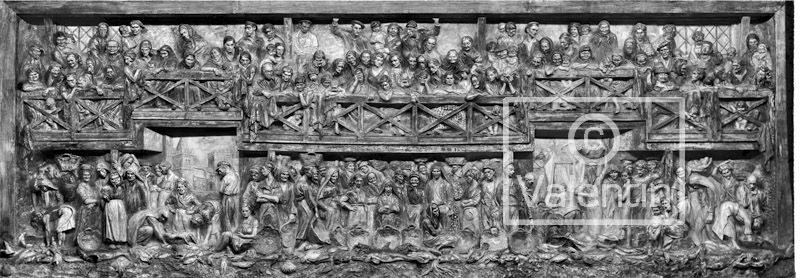
Recuerdo algunas conversaciones con mi abuelo hablando sobre las fotografías que éste había hecho de la escultura conocida como El Retablo del Mar, de Sebastián Miranda. Ocurrieron cuando empecé a meterme en el mundo de la fotografía y advertí el “ojo clínico” de mi abuelo, retirado hacía ya varios años, que de cuando en cuando, pasaba por el estudio mirando lo que por allí había sin tocar nada. Teníamos una pequeña conversación y seguía con su paseo diario.
I remember some conversations with my granddad talking about the photographs that he had taken of the sculpture known as El Retablo del Mar, by Sebastián Miranda. This happened when I began to get into the world of photography and noticed the "clever eye" of my grandfather, at the time retired a few years before, who, from time to time, payed a visit to the studio looking at what we were doing, but without touching anything. We had some short conversations and then he continued with his daily walk.
También recuerdo a Sebastián Miranda moviéndose por el estudio de mi abuelo, mirando copias y comentando anécdotas de todo tipo. Yo era entonces un adolescente y no me preocupaba demasiado de aquellos asuntos. Sebastián era un hombre grandote, asequible, de un hablar bastante brusco y que se reía con sonoras carcajadas. Lo invadía todo con su humanidad y tenía una energía arrolladora. Siempre me ha recordado a Camilo José Cela en su comportamiento.
I also remember Sebastián Miranda moving by my grandfather's studio, looking at copies and commenting on anecdotes of all kinds. I was then a teenager and did not care too much about these matters. Sebastian was a big man, approachable, with a rather brusque speech and who laughed out loud. He invaded everything with his humanity and had overwhelming energy. He has always reminded me of Camilo José Cela in his behavior
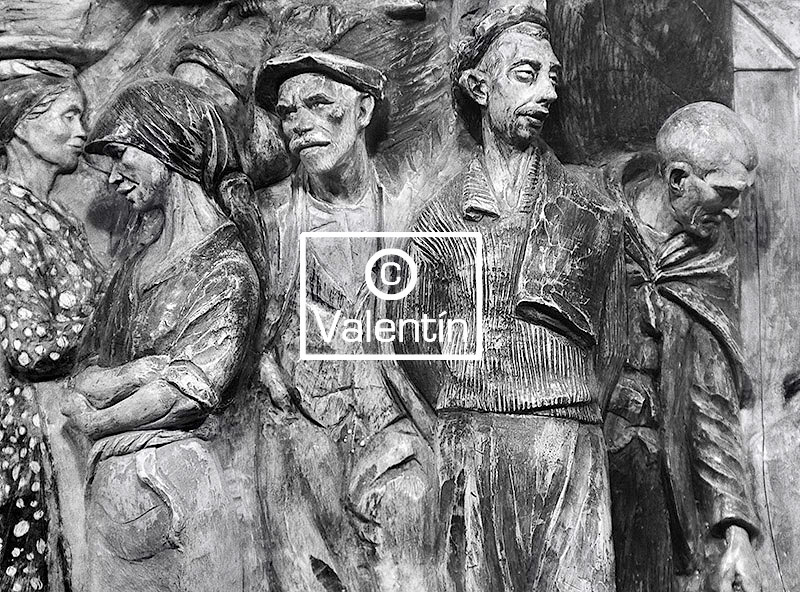 (Detalle – Close up)
(Detalle – Close up)
Hacia 1970 su presencia era muy frecuente en el estudio. Estaba trabajando en el que sería su segundo retablo, sustitución del destruido cuando la guerra civil española (1936-1939), y con frecuencia visitaba a mi abuelo. Supongo que, dadas las circunstancias, era para analizar datos del anterior y tomar decisiones con el nuevo..
By 1970 his presence was very frequent in the studio. He was working on what would be his second Retablo, replacing the one destroyed during the Spanish Civil War (1936-1939), and frequently visited my grandfather. I guess, given the circumstances, it was to analyze data from the old Retablo and take decisions about the new one.
Con el paso de los años desaparecieron los actores de estos recuerdos. Las cajas en las que guardaba los archivos de mi abuelo quedaron cuidadosamente almacenadas en un arcón, preservando su contenido. Sabía que había dentro muchas placas de cristal, cientos diría, pero en más de quince años creo que solo abrí una vez el arcón para asegurarme de que allí todo seguía en perfecto estado. También sabía que entre todo ello se guardaba la caja de “Papel fotográfico Negtor”, en la que dormían las placas de cristal del Retablo original, pero no toqué nada, cerré la tapa del arcón y todo volvió a su sueño.
Over the years the actors of these memories disappeared. The boxes in which I kept my granddad's files were carefully stored in a quite big chest, preserving their contents. I knew there were many glass negatives inside, hundreds I would say, but in more than fifteen years I think I only opened the chest once, to be sure that everything there was still in perfect condition. I also knew that, among all this glass negatives, there was kept the box of “Negtor photographic paper”, in which the glass plates of the original Retablo slept, but I did not touch anything, I closed the lid of the chest and everything returned to its dream.
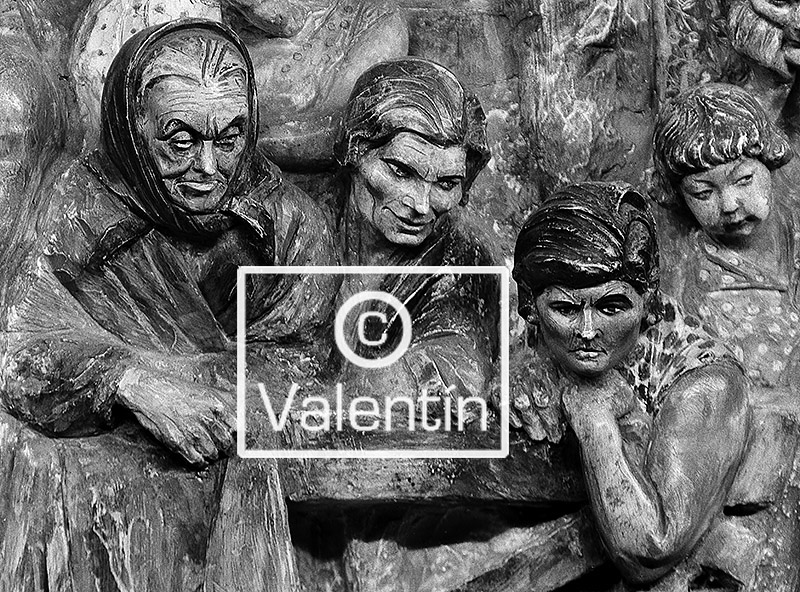 (Detalle – Close up)
(Detalle – Close up)
En 2019 surgió un proyecto fotográfico personal que me iba a llevar muy lejos de España durante varios años y, como no tenía nada mejor que hacer, decidí aceptarlo. Para ello debería terminar los proyectos en curso y organizar la estructura que iba a necesitar mi vida personal en esos años. Hice mis cálculos y decidí iniciar el nuevo proyecto a partir de 2022. Fue entonces cuando comencé a preocuparme por aquellos archivos guardados de mi abuelo, por saber cuál era el interés de su contenido y qué hacer con ellos durante mi larga ausencia. En todo caso quería que estuvieran a buen recaudo para el futuro.
In 2019 a new personal photographic project emerged that was going to take me very far from Spain for several years and, since I had nothing better to do, I decided to accept it. For this, I would have to finish the projects in progress, and organize the structure that my personal life was going to need in those next years. I did my calculations and decided to start the new project from 2022 on. It was then that I began to worry about those saved glass negatives of my grandfather, I needed to know what was the interest of their content and what to do with them during my long absence. Specially, I wanted them to be safe for the future.
Tocaba investigar en los archivos de mi abuelo y mirar con cariño hacia la prehistoria de la fotografía. Lo primero que busqué y abrí fue la caja que contenía las placas de cristal en formato 13 x 18 del Retablo. Su nombre estaba escrito en el exterior de la misma. Al revisarlas pude comprobar que eran interesantes, estaban en buen estado y también había alguna toma parcial. Una de las placas de cristal estaba recuadrada con papel negro y dentro del marco se veía el Retablo. Esa debía ser la placa seleccionada para las copias.
I had to investigate my grandfather's archives and look fondly towards the prehistory of photography. The first thing I searched for, and opened, was the box that contained the 13 x 18 glass plates of the Retablo. The name was written on the outside of it. When reviewing them I could verify that they were interesting, they were in good condition and there were also some partial takes of the Altarpiece. One of the glass plates was surrounded with black paper and inside the frame you could see the Altarpiece. This had to be the one selected for the copies, I thought.
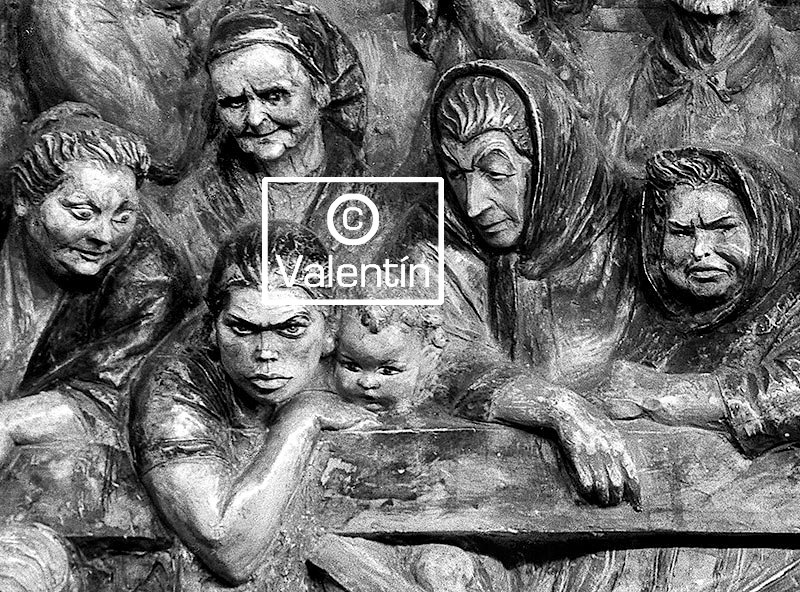 (Detalle – Close up)
(Detalle – Close up)
En un corto viaje a Gijón me acerqué al Museo Casa natal de Jovellanos, localización del actual Retablo desde hace muchos años, para hablar con su directora, Lucía Peláez, sobre los archivos del original. Mostró interés por conocer el alcance real de lo encontrado y quedamos en que le pasaría un informe más exacto. Es aquí donde comienza la verdadera historia de lo que la prensa ha llamado “El Renacer del Retablo del mar”.
On a short trip to Gijón I went to the Jovellanos Birthplace Museum, the location of the current Retablo for many years, to speak with its director, Lucía Peláez, about the original archives founded. She showed interest in knowing the real scope of what was found and we agreed that a more accurate report would be passed on to her. This is where the true story of what the press has called "The Rebirth of the Altarpiece to the Sea" begins.
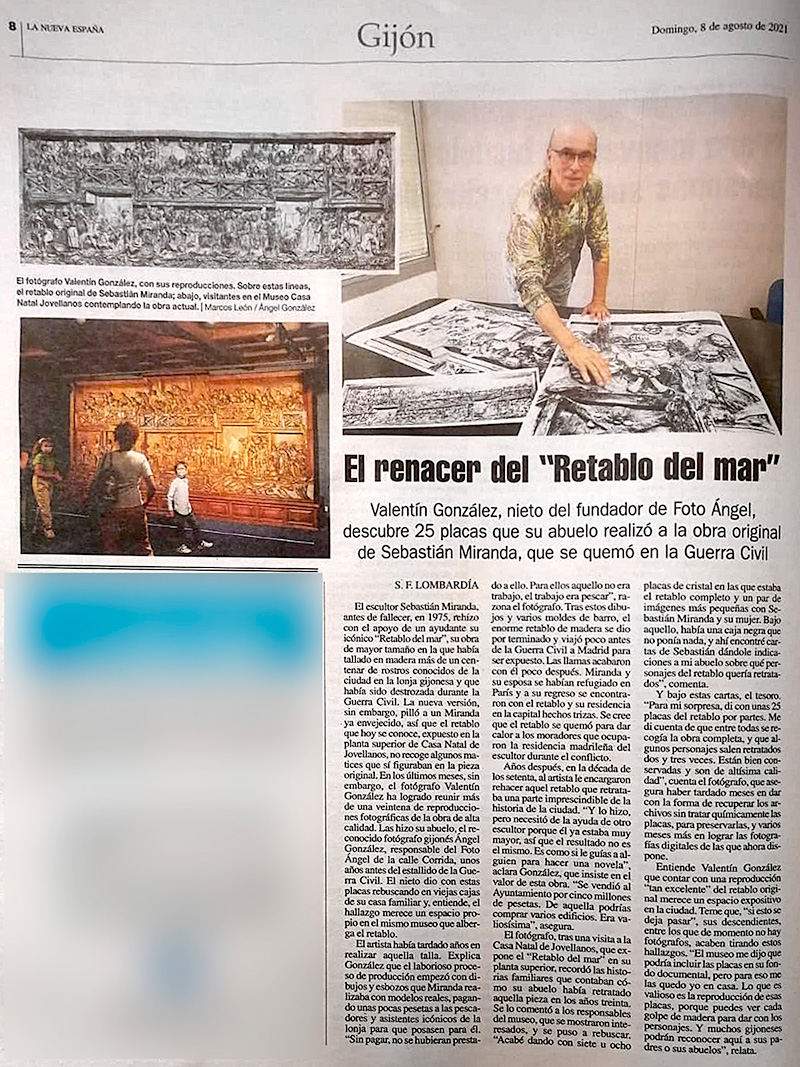
Al volver a casa miré más a fondo en los archivos y me llevé una buena sorpresa con lo que encontré.
Back home from Gijón I looked more deeply in the chest and, to my surprise, I found more than expected.
Yo sabía de la existencia de una caja con las placas de cristal, pero había más información por descubrir. En una segunda caja sin rotular había cartas entre mi abuelo y Sebastián Miranda, además de documentos particulares sobre el Retablo, como encargos de copias y cosas así. Pero bajo este sobre con documentos encontré más de veinte placas de 13 x 18, en soporte de gelatina, de las que un par eran del conjunto y el resto correspondían a tomas parciales. Yo desconocía la existencia de este material.
I knew of the existence of a box with the glass negatives, but there was more information to discover. In a second unlabeled box there were letters between my grandfather and Sebastián Miranda, as well as private documents about the Retablo, such as orders for copies and stuff like that. But under this envelope with documents I found more than twenty 13 x 18 film negatives –in gelatin support–, of which a couple were from the entire piece, and the rest corresponded to partial shots. I was unaware of the existence of this material.
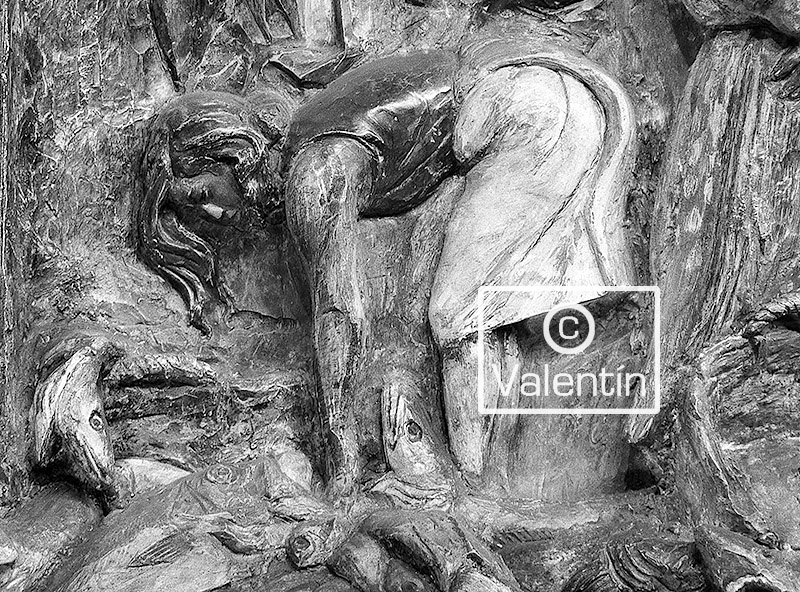 (Detalle – Close up)
(Detalle – Close up)
En total había encontrado más de treinta placas, a las que había que añadir algunas de tomas pertenecientes a la restauración del nuevo Retablo, con escayola húmeda, etc.
In total, I had found more than thirty plates, to which had to be added some of the shots belonging to the restoration of the new Retablo, with wet plaster, etc.
Las tomas parciales cubrían la totalidad del Retablo por piezas, duplicando y hasta triplicando la captura de algunos personajes que aparecían en las placas, con disparos hechos siempre de frente, pero desde distintas posiciones. Por decirlo de alguna manera, el Retablo podría volver a montarse como un puzle con los diferentes parciales.
The partial shots covered the entire Retablo in pieces, doubling and even tripling the capture of some characters that appeared on the plates, with shots always taken from the front, but from different positions. So to say, the Retablo could be reassembled as a puzzle with the different partials.
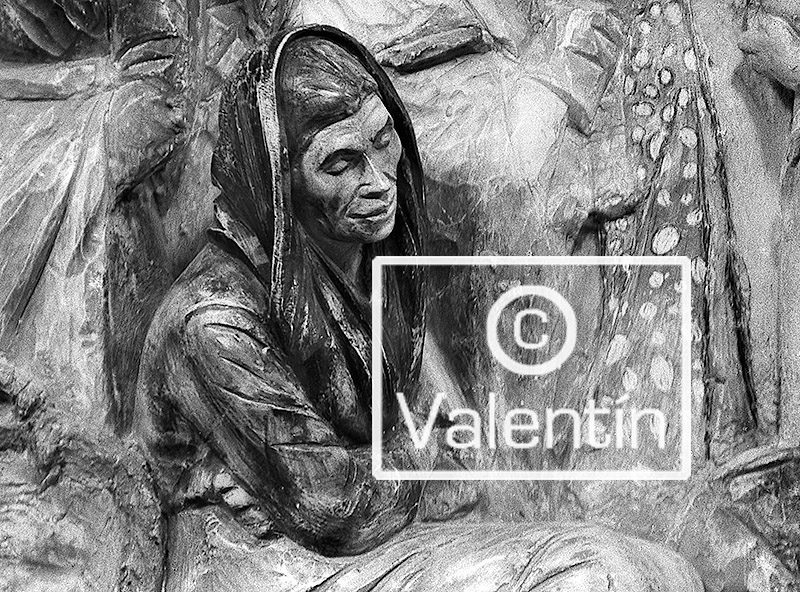 (Detalle – Close up)
(Detalle – Close up)
Si bien las placas, tanto las de cristal como las de gelatina, son de 1932, su estado de conservación es, en general, razonablemente bueno, lo que me ha permitido obtener, de cada una de ellas, archivos digitales muy grandes, con mucha profundidad y altísima resolución, para proceder a su restauración conservando el original intacto. Mi rechazo a la regeneración química de las placas ha sido frontal desde el primer momento. Lo sentía como jugar con fuego.
Although the plates, both glass and gelatin ones, are from 1932, their state of conservation is, in general, reasonably good, which has allowed me to obtain, from each one of them, very large digital files with a lot of depth and very high resolution, to proceed with its restoration while preserving the original intact. My rejection of the chemical regeneration of the plates has been frontal from the first moment, to me it seemed like playing with fire.
La recuperación digital del contenido de las placas, desde el método de captura hasta el proceso de rescate de información y limpieza, ha sido laborioso y técnicamente complejo. No aburriré con detalles técnicos para iniciados, pero dejaré un corto apunte para curiosos: Dado que no todas las placas tenían la misma densidad, contraste de toma, definición o suavidad de procesado, fue necesario preparar una caja especial para jugar con la difusión de la luz empleada en cada digitalización. Las capturas se trabajaron en cinco capas directamente en Raw, separándolas según su densidad para recuperar los detalles. Por cierto, las placas son ortocromáticas. Me sorprendió que los negativos de cristal tenían mejor calidad que los de gelatina. Y hasta aquí los detalles aburridos.
The digital recovery of the content of the negatives, from the method of capture to the process of information rescue and cleaning, has been laborious and technically complex. I will not bore you with technical details, but I will write here a short note for the curious: Since not all plates had the same density, light contrast, definition or processing smoothness, it was necessary to prepare a special box to change the diffusion of the light used in each scan. The captures were worked in five layers directly in Raw, separating them according to their density to recover the details. By the way, the plates are orthochromatic. To my surprise the glass negatives were of better quality than the gelatin ones. And no more boring details.
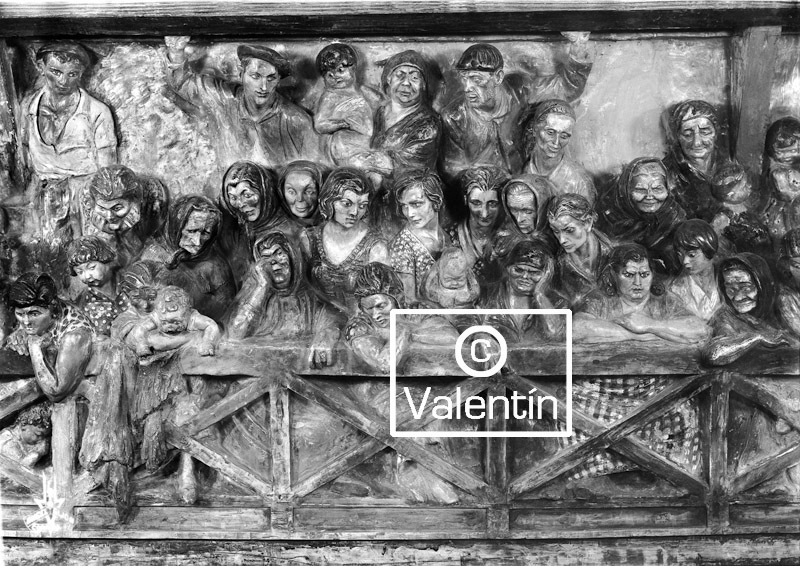 (Detalle – Close up)
(Detalle – Close up)
El proceso de recuperación de cada placa se hizo milímetro a milímetro en el archivo digital, y necesitó una media de seis días de trabajo. La calidad de las veinticinco imágenes rescatadas tras varios meses de meticuloso esfuerzo en el laboratorio es, en mi opinión profesional, absolutamente impresionante. Muchas de ellas parecen haber sido capturadas ayer mismo.
The recovery process of each plate was done millimeter by millimeter in the digital archive, and it took an average of six days of work. The quality of the twenty-five images rescued after several months of meticulous effort in the laboratory is, in my professional opinion, absolutely impressive. Many of them seems to have been captured yesterday.
Los archivos digitales extraídos de las imágenes ofrecen la posibilidad de realizar una magnífica exposición de la pieza perdida, como hasta ahora no se había podido hacer –ni soñar–, con dos docenas de ampliaciones de buen tamaño, en materiales y procesos de calidad museo y certificadas. Cuando hablo de tamaños quiero decir piezas de un metro de lado, e incluso más. Se podría publicar un libro con los despieces disparados en las placas encontradas, e incluso con los recortes de los personajes, además de la reproducción de la toma general. Incluso podrían compararse en el libro imágenes de ambos retablos separados por el tiempo. La calidad de lo conseguido lo permite sin ninguna duda.
The digital files extracted from the images offer the possibility of making a magnificent exhibition of the lost piece, as until now it had not been possible –or even dreamed–, with two dozen good-size enlargements, in museum-quality materials and processes, and certified. When I talk about sizes, I mean pieces of a meter on one side, and even more. A book could be published with the different images of the plates found, and even with the faces of the characters, in addition to the reproduction of the general shot. Images of both Retablos separated by time could even be compared in the book. The quality of what has been achieved allows it without any doubt.
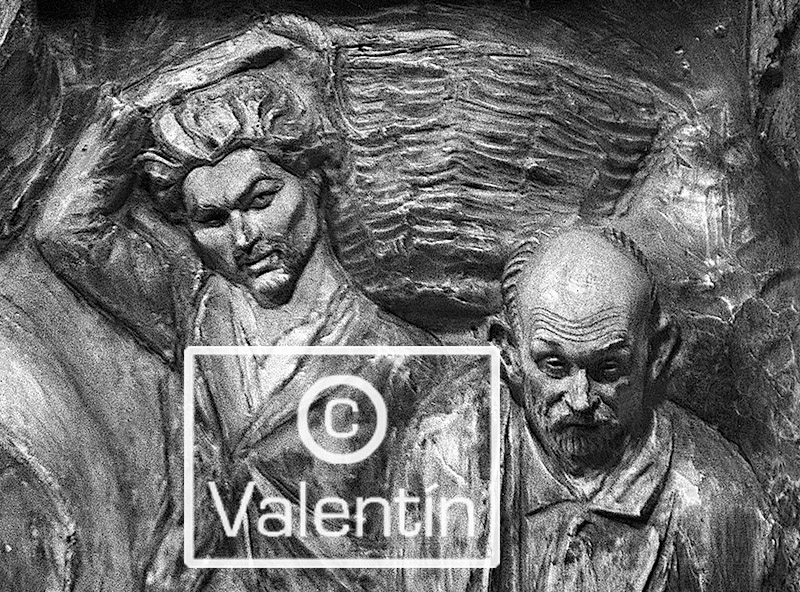 (Detalle – Close up)
(Detalle – Close up)
Hoy, tras los meses empleados en el trabajo y visto el resultado alcanzado, considero más importantes los archivos digitales que las propias placas. De acuerdo que los negativos son el origen y respaldan nuestro esfuerzo, pero como con los diamantes, el tallado les ha dado nueva vida. Además, evidentemente, no son tan frágiles, ni tan limitados. No van a caer y romperse, no van a rayarse, llenarse de hongos o, sencillamente, perder la imagen soportada en plata. La información presente en los negativos ahora suena por altavoz en la restauración numérica.
Today, after the months spent at work, seeing the result achieved, I consider the digital files more important than the plates themselves. For sure, the negatives are the real witness of the lost Retablo, and the reason for our effort, but as with diamonds, the cut has given them new life. Also, obviously, digital archives are not so fragile, nor so limited, they will not fall and break, they will not get scratched, be destroyed by fungus or simply lose the image supported in silver. The information present in the negatives now sounds with loudspeakers in the numerical restoration.
Hay una genialidad que quiero reivindicar desde estas líneas para el autor de los disparos: Ángel González Pérez. De paso hago un poco de historia de la fotografía ahora que estamos pisando su doscientos aniversario.
There is a genius that I want to vindicate from these lines: the author of the shots, Ángel González Pérez. By the way, I´ll tell a little part of the history of photography, now that we are close to its two hundredth anniversary.
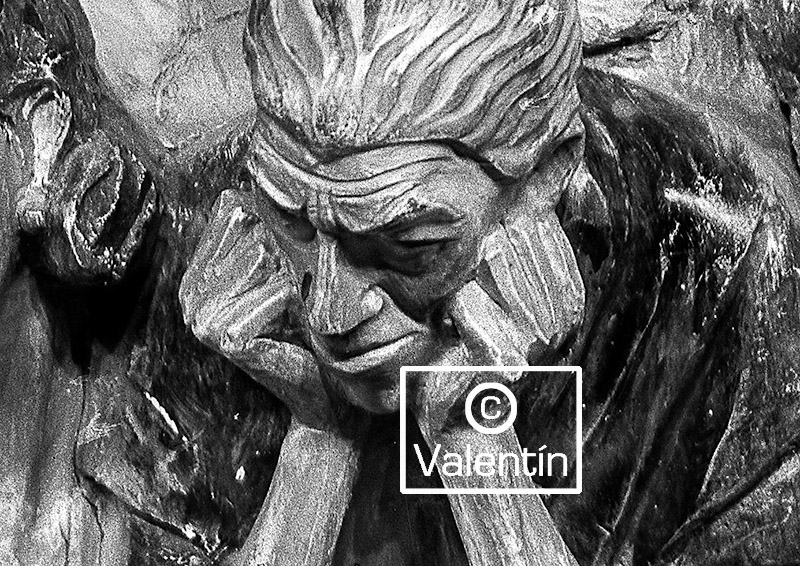 (Detalle – Close up)
(Detalle – Close up)
En 1932 la fotografía no era lo que es ahora, las placas eran muy poco sensibles, las ópticas eran bastante ciegas, las cámaras eran muy grandes y no había sistemas de iluminación razonables. Los estudios se situaban en la parte alta de los edificios para que a través del cristal de una “galería”, entrara la potente luz solar y así limitar a unos pocos segundos los disparos. Para evitar que se movieran los modelos se les sujetaba apropiadamente, incluso con inmovilizadores de cuello colocados desde atrás para esconderlos a la cámara. Tener el estudio en un edificio con ascensor era un extra a considerar seriamente.
In 1932 photography was not what it is now, the negatives had very low sensibility, the optics were quite blind, the cameras were very large, and there were no reasonable lighting systems. The studios were located in the upper part of the buildings so that, through the glass of a "gallery", the powerful sunlight would enter and thus limit the shots to a few seconds. To prevent models from moving, they were properly restrained, even with neck restraints placed from behind to hide them from the camera view. Having the studio in a building with an elevator was a bonus to seriously consider.
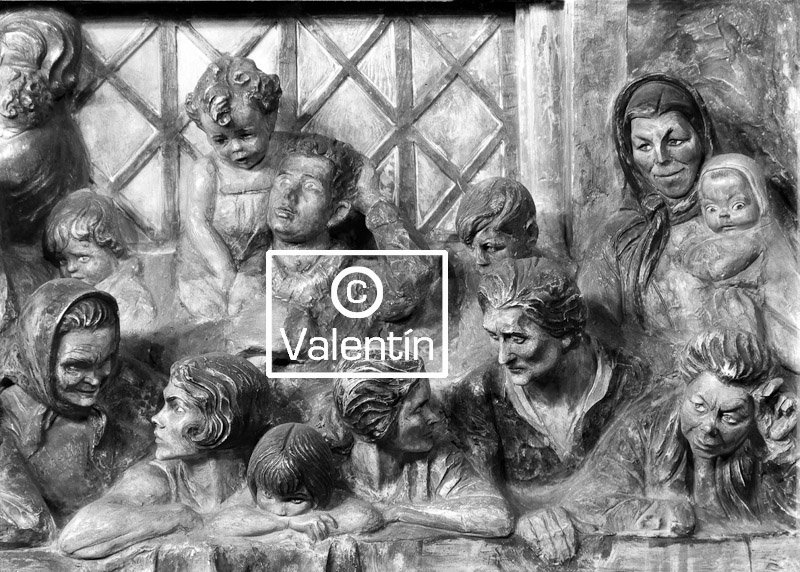
(Detalle – Close up)
En esos años y con aquellas condiciones técnicas, reproducir adecuadamente una pieza del enorme tamaño del Retablo en un lugar mal iluminado era casi misión imposible. Sé que Sebastián había probado con otros expertos sin conseguir resultados satisfactorios antes de hablar con mi abuelo. Entonces ¿cómo lo hizo?
In those years and with those technical conditions, adequately reproducing a piece of the enormous size of the Retablo in a poorly lit place was almost an impossible mission. I know that Sebastian had tried some other experts without getting satisfactory results before talking to my grandfather. So how did he do it?
Ángel usó una potente bombilla con una tulipa, que estaba conectada con un alargador a la red de 125v. Oscureció la habitación completamente, disparó la cámara, se dirigió a la esquina izquierda del retablo, encendió la luz y comenzó a contar segundos mientras hacia círculos con su mano y la tulipa, iluminando la parte de arriba. Tras contar diez segundos se movió a la derecha un metro y siguió iluminando en círculos la pieza, continuando con el proceso todo el trayecto hasta llegar al final de la parte derecha. Luego volvió hacia al punto de partida repitiendo la técnica con la parte de abajo.
Ángel used a powerful bulb with a tulip, which was connected with an extension cord to the 125v network. He darkened the room completely, shot the camera, went to the left corner of the Retablo, turned on the bulb light and began counting seconds while making big circles with his hand and the lampshade, illuminating the upper part. After counting ten seconds, he moved one meter to the right and continued to illuminate the piece in circles, following the process all the way until he reached the end to the right side. Then he returned to the starting point, repeating the technique with the bottom part.
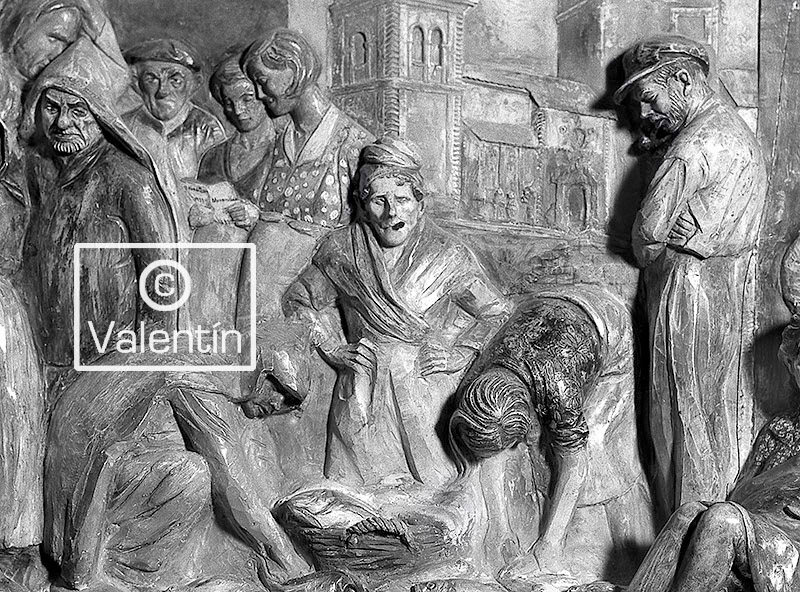 (Detalle – Close up)
(Detalle – Close up)
Procesó la placa y vio que estaba corta, que necesitaba veinte segundos en cada zona y, además, era preciso hacerlo en tres filas en vez de en dos, porque el centro de la pieza lo exigía. Tras varios intentos quedó satisfecho con la placa procesada y, parece ser que, Sebastián Miranda también.
He developed the plate and saw that it was underexposed, that it needed almost twenty seconds of light in each area and, furthermore, it had to be illuminated in three rows instead of two, because all the central line of the Retablo demanded it. After several attempts he was satisfied with the processed plate and, it seems that, Sebastián Miranda was satisfied as well.
La afortunada idea usada en la captura y la apropiada conservación hecha de las placas, me ha permitido extraer de ellas unas imágenes que multiplicaron mi admiración por su calidad como fotógrafo, a la vez que perpetúan inesperadamente el Retablo original. Son un legado que nos permite acceder a una extraordinaria obra de arte desaparecida y un regalo para nuestros ojos. Es el “Yo estuve aquí” del primer Retablo del mar.
The fortunate idea he used in the capture, and the appropriate conservation made of the plates, has allowed me to extract from them some images that multiplied my admiration for his quality as photographer, at the same time that they, unexpectedly, perpetuate the original Retablo. They are a legacy that allows us access to an extraordinary missing work of art and also a gift for our eyes. It is the "I was here" of the first Retablo del mar.
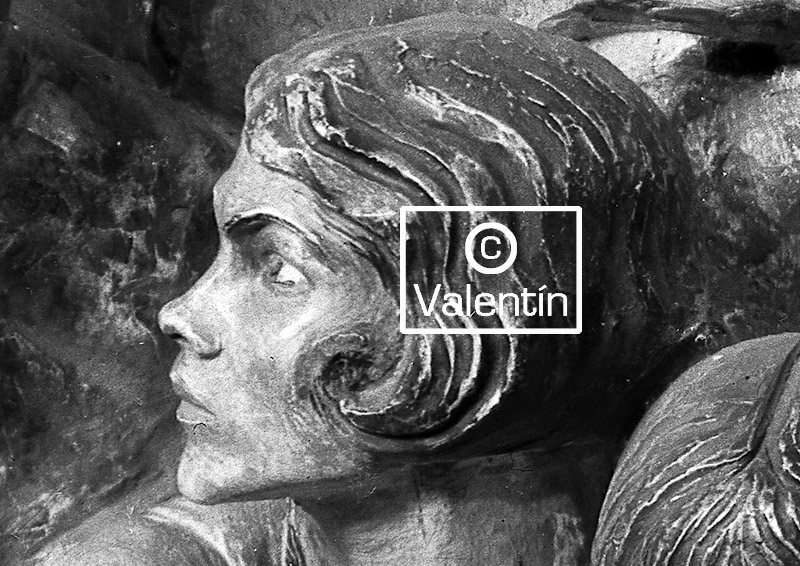 (Detalle – Close up)
(Detalle – Close up)
Va por ti, abuelo.
Dedicated to my grandfather.

